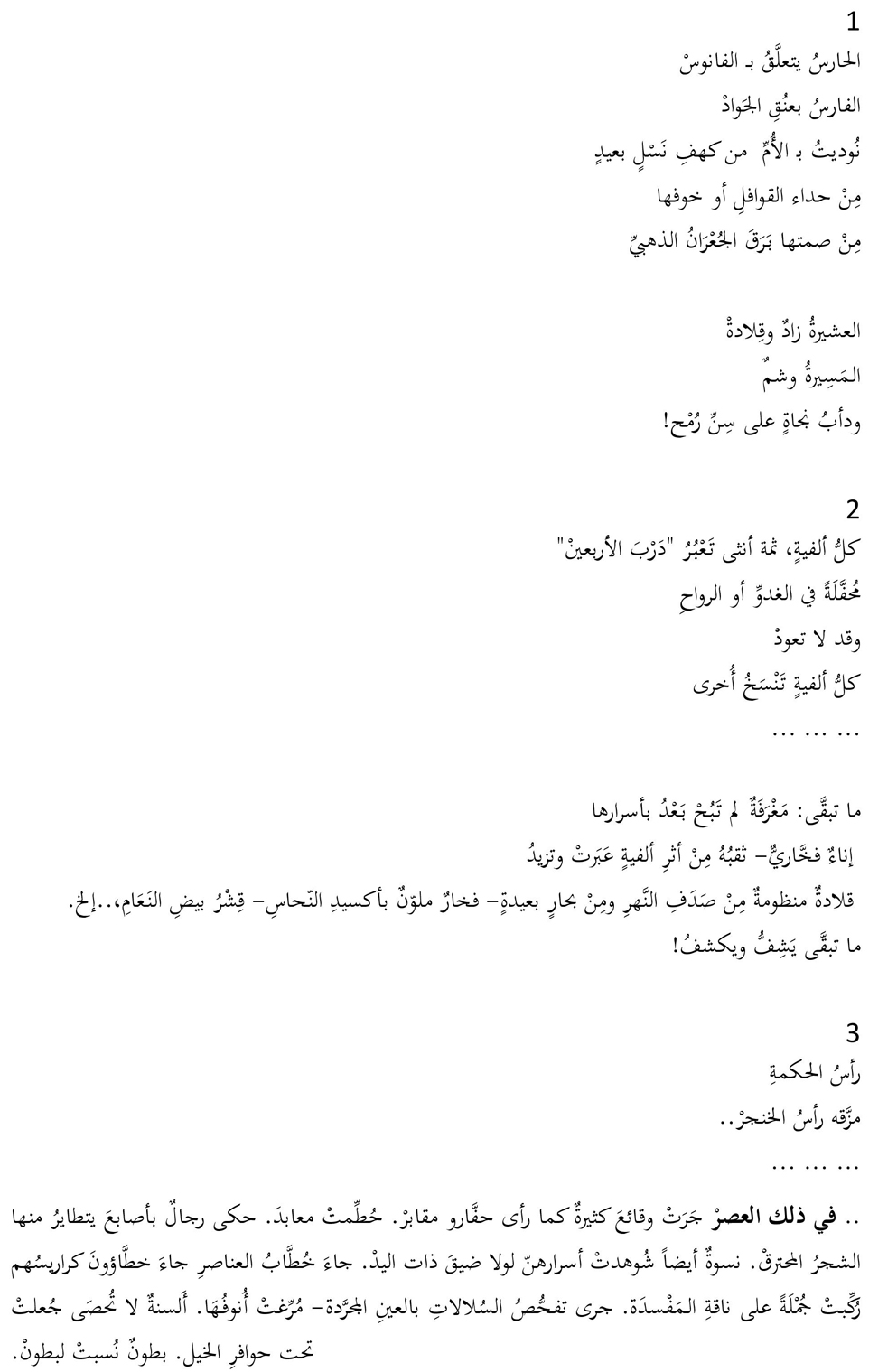

Traces of an Unknown Woman
1
The watchman cleaves to his lantern
The knight clings to the neck of his horse
My name was passed down from mother to daughter –
like the songs sung by caravans to bolster their courage
My name is the gleam of a golden scarab
The tribe is both sustenance and a finely-wrought necklace
The journey is like a tattoo
Survival is balanced on the point of a spear
2
Each millennium a woman journeyed along Darb Al Arbaien 1
Richly attired as she travelled the road back and forth
She may not return
Each millennium she starts out once more
... ... ...
What remains: a ladle that keeps its own counsel
A clay pot punctured by millennia
A necklace of shells from distant seas, of shells gleaned from a far-off riverbed – pottery
stained with the patina of copper – the blown egg of an ostrich, etc, etc
What remains: revelation
3
The fount of wisdom is pierced by
the point a dagger
... ... ...
An epoch of atrocities witnessed by the diggers of graves. Temples razed to the ground. Tales told by men whose fingers fire flames. Violated women branded by poverty, scorned with shame. Then came the discourse of separation and selection. Then came camp followers, wielding division, corrupt catalogues of sins straddled on camels, difference decreed by the naked eye. Numberless tongues were ripped out to be trammelled under the hooves of horses.
The end of a tribe is a tribe.

Two Nubian pottery vessels, and string of beads placed in the isolated burial of a woman near village cemeteries north of Qau, in Middle Egypt: highly polished black silt scoop, of a form known from central Sudan uc17888; black-topped bowl with hole punched through wall, perhaps to avoid recycling by the living uc17889; beads uc26013 (and see ‘The Golden Scarab Necklace’) 1800-1600 bc
1 This group of Nubian pottery and beads is from a burial of a woman, recorded by archaeologist Guy Brunton as no.1989 in his publication of cemeteries on the east bank of the Nile between Qau and Asyut in Middle Egypt. Here, desert roads connect the river valley, west to the oases, east towards the Red Sea, and on both sides onward south to Sudan; the most famous of these routes is Darb al Arbain ‘Road of Forty Days’, leading from Darfur in western Sudan to the Kharga Oasis and across to Asyut. No other Nubian burial is recorded in this or the nearest cemeteries, but the desert foothills in the area sheltered some small, perhaps seasonal settlements of desert Nubians. The other grave goods were leather sandals (Egyptian burials of this date avoid animal skins), a bone awl, two Spatha shells from the Red Sea, and a north Egyptian scarab. The body of the woman was not recorded in detail, so her precise age and ethnicity are unknown, but those who buried her were following desert Nubian customs.
Impact (influence) of a strange woman
1
The guard dangles from the lantern
The knight from the neck of his horse
I was called (given the name of) a Mother from the cave of old pedigrees
By the vocalisation of caravans or by its forebodings
By the silent shimmering of golden scarab
The clan is nourishment, and a necklace
The journey is a tattoo
And the persistence of escape balanced (depends) on the tip of a spearhead!
Every millennium, a female trekked through (Darb Al Arbaien) {1}
Well groomed, roaming the road back and forth
She may not return
Every millennium annuls the previous one
……… ……… ... ...
All that remained is: a ladle that decline to divulge its secrets yet
An earthen pot – with a hole caused by the passing of millennia or more –
A necklace of seashells from the River or far- away seas – pottery stained with Copper oxide – ostrich egg shells …etc.
What remained reveals and discloses!
3
The head of wisdom {2}
Tattered by the head of the dagger
……. …….
In that epoch, many things happened, things witnessed by grave diggers. Temples were destroyed. Told the men, from whose fingers flies burnet tries. Also, secrets of women were disclosed, lest they were underprivileged. Here came the discourse of elements, came the sinners with their books mounted (straddled) on camels of corruption, breed-strains examined by the naked eye - its nose rubbed in dirt. Innumerable tongues were trampled on under the hooves of horses.
Clans affiliates (belong) to clans
{1} Darb Al Arbaien is a famous desert road for caravans from Sudan and Egypt, Starts in Omdurman and ends at Umbaba in the Nubian region of south Egypt
{2} The head of wisdom (Rass Al Hikma) means the ultimate degree of wisdom and shrewdness, a condensed state of knowledge, judgement and insight
Atef Alshaer, Literal Translator
